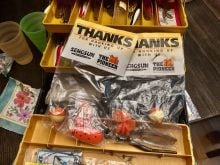Once again, a year’s passed and for better or worse
We start a new one in doggerel — that’s badly rhymed verse
We review the last year (which you could say was a hexed one)
And give you some tips on what to do in the next one
Now I’ve heard all the stories while sitting on Grandpa’s knee
About drought in the ’30s and dogs being chased by the trees
“Yes Grandpa, I know it was ‘sooo… dry,’ — I’m not saying you’re a liar
Read Also

When farmers vote against their interests
U.S president Donald Trump has left many clues over the years that many of his actions weren’t going to necessarily be in the best interests of American farmers.
Children ask today’s grandpas, “What seems to be stopping
“You from using those areas by the road? They look good for cropping”
Says Grandpa, “Why, those are called ditches; they’re connected to drains
“They’re for taking away all the water soon after it rains”
“But Grandpa,” says the child, “That doesn’t seem comprehendible
“Wouldn’t holding some water back be a little more sensible?”
Now most creatures need water to keep on surviving
But there’s two that with less moisture are even more thriving
I’ve heard all Grandpa’s stories about grasshoppers perfidious
But these days there’s a dry-weather critter that’s just as insidious
And now there’s two types you know — spotted and crucifer
I hear that spraying them with chemical was often defective
So I think a method that would be much more effective
Would be to suck, not spray, those cursed little dickens
Vacuum them up and turn them into good feed for chickens
Despite a moisture total that was anything but seasonable
Many farmers had grain yields that were actually quite reasonable
So thanks to those who’ve designed better cultivators and seeders
And to better varieties that have come from plant breeders
But I’m afraid you can’t say the same for hay crops and forage
In a drought like last summer’s they don’t grow much foliage
A lot of good cattle had be be shipped off to town
Many farmers were miffed that their prices were quite stationary
Meanwhile the beef price at retail became somewhat inflationary
I just paid 25 bucks for a rib steak, but I’m not being hasty
To complain, because it was grass fed, and really quite tasty
Speaking of inflation, if you don’t want to be teary
Ya had better not check prices for ammonia and urea
Is it more economical to broadcast, or to band with a drill?
Neither — this year you’ll need tweezers to place every prill
A few years back it was common to hear at farm meetings
Skeptics who questioned whether there’s in fact global heating
On advice from most of the experts who agree on the science
But while on climate change theory, most scientists were for it
Farmers were told they were wrong, and advised to ignore it
Since Health Canada approves ag chemicals based on science and facts
If you use them then don’t say it’s wrong about getting vaxxed
I don’t know about you but I’m finding it hard
To remember the ag department’s name — the latest is MARD
There was MAF, MAFRD and MAFRI, so it would be indicative
Of the need to emphasize food and rural initiative
Then back to MDA — while Pallister in ego and height was quite taller
Whatever you call the ag department, I think farmers have good luck
The staff there seem to provide a pretty big bang for the buck
The editor says last year’s doggerel was too long, so he had to cut plenty
Including my prediction of wheat going to 10 bucks, and canola over 20
Can these prices continue? Well, the way that I figger
It would be OK to have them a bit lower, but the crop a lot bigger
Which crops to grow? Well, I think that we’re likely to sees
More acres of those that make their own N, like soybeans and peas
That’s probably OK, but for peas my advice is
To plant the kind that doesn’t get aphanomyces
For soybeans you now have to watch for nematodes on cysts
How about barley? To plant a few acres, I wouldn’t be halting
Especially if you choose the kind that goes malting
As for weather, I think for Feb. and March we’ll be having
Temperatures around normal, and not too bad for calving
What about snowfall, will this winter’s be thick?
Maybe, but even so, it will soak in real quick
So after an early start to seeding, I’m sure what I sees is
Weekly rain in June and July, but not so much as to cause diseases
Scattered showers in August and September are what I’m seein’
But not on cereals and oilseeds — only on fields with soybean
That’s all the space for predictions, so from all of us here
Best wishes for good crops and good prices, and Happy New Year!















